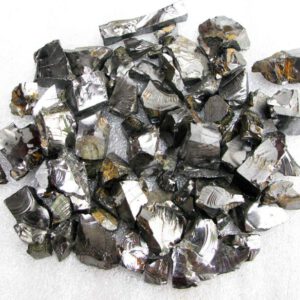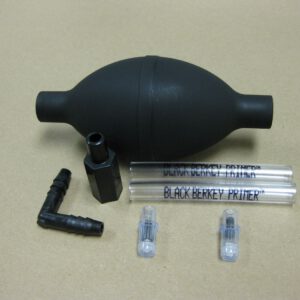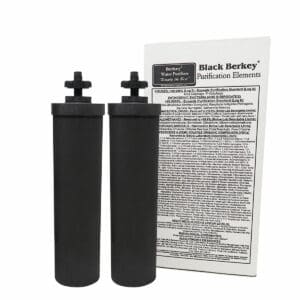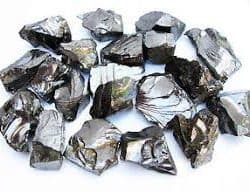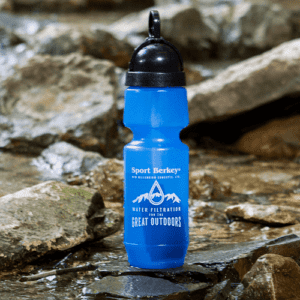Always sold as a Set of 2
- Berkey® PF-2™ Fluoride & Arsenic Filter are designed to be used in conjunction with the Black Berkey® Purification Elements only
- Constructed of: Non-leaching Polypropylene #5 that is BPA-Free plastic
- Use with Berkey Systems: Travel, Big, Royal, Imperial, Crown and Berkey Light
- PF-2™ Fluoride & Arsenic Filter attaches to the bottom of the Black Berkey® Purification Elements and sits in the lower chamber of the Berkey unit
- Number of PF-2™ Fluoride & Arsenic Filter in the bottom chamber must match the number of Black Berkey® Filter in the top chamber; for example, 4 Black Berkey® Purification Elements would require 4 PF-2™ Fluoride & Arsenic Filters
- Filter Capacity: 3,785 litres per set of two under normal usage. Note that high levels of Fluoride, arsenic and heavy metals can reduce the capacity and efficiency of the filter.
- Recommended PF-2™ Fluoride & Arsenic Filter Replacement: If the system is refilled about one time per day, the PF-2™ Fluoride & Arsenic Filters should be replaced after 12 months, if the system is refilled about twice per day, the PF-2™ Fluoride & Arsenic Filter should be replaced about every 6 months.
- PF-2 filters reduce the filtration flow rate by 15-20%
- How to Prime and Install the Berkey PF-2™ Fluoride and Arsenic Filters Video: CLICK HERE
Berkey PF-2™ Fluoride & Arsenic Filter
The Berkey PF-2™ Fluoride & Arsenic Filter work in conjunction with the Black Berkey® Purification Element as they fit onto the end of the Black Berkey® Purification Element while sitting in the lower chamber of a gravity filter unit as shown. They will fit into all of the Berkey systems EXCEPT the Go Berkey Kit.
These FILTER and REDUCE as follows (with Black Berkey® Purification elements):
- Fluoride
- Arsenic V and peroxidized Arsenic III
- (Targets entire family of arsenic oxide anions as well as the arsenic cations)
- Other residual heavy metal ions
USAGE
- Do not boil element
- Total filtration flow rate reduced by 15-20% due to added water purification
Technical Information and Testing
Testing for fluoride was based on 20-30ppm of the ion in the influent aqueous solution at a flow rate of no more than 3 gpm (11 lpm) per cubic foot of media. Results of < 1ppm of the fluoride ion in the effluent were typical for the media (>95% reduction). Under optimum conditions, effluent concentrations of less than 50 ppb were readily achieved (>99.75% reduction). This product uniquely targets the entire family of arsenic oxide anions as well as the arsenic cations.
Our original tests were done using gravity alone to purge the PF-2 filters. Since then, we have added a step by using purging buttons which are much more efficient at removing any residual process dust from the PF-2 media. The test does not distinguish between activated alumina (Al2O3) and Aluminum (Al). So we had to use the total count of aluminum and activated alumina in our tests.
PF-2 filters contain high-grade activated alumina (Al2O3), which currently is the most efficient media available for extracting fluoride from water. Activated alumina is inert. Below are the results we obtained when testing the PF-2 filters (the water was not pre-filtered through the Black Berkey® filter elements). The reduction over time is due to additional residual process dust being washed free from the PF-2 filter as the system is used. To give a scale for comparison purposes we include test results from a national brand toothpaste and water boiled in an aluminum pan.
- National brand toothpaste 52.878 ppm aluminum
- Water boiled in an aluminum pan for five minutes: 2.791 ppm aluminum
- PF2 after conditioning (5 cycles): .178 ppm aluminum
- PF2 after 10 Cycles: .037 ppm aluminum
- PF2 after 20 Cycles: .029 ppm aluminum
While the above results indicate that the residual process dust adds a minute amount of activated alumina to the water, the Black Berkey® filter reduce aluminum from the water. We tested water that naturally contained .320ppm aluminum and filtered it through the combination of the Black Berkey® filter and the post conditioned PF-2 filtration elements (5 cycles). The results showed a net reduction in aluminum contamination (Raw influent: .320ppm – Effluent after passing through the Black Berkey® filter and PF-2 filter : .232ppm). Again, the standard tests cannot distinguish between aluminum (Al) and activated alumina (Al2O3), which is inert. Nevertheless, the tests showed a net reduction by the Black Berkey® filter in the combination of naturally occurring aluminum plus any residual activated alumina (Al2O3) process dust from the PF-2 elements.
In other words, the Black Berkey® filter removed more aluminum from the water than was added by the Berkey PF-2™& Arsenic Filter.
Replacement
Under normal conditions, we recommend that two PF-2 filters be replaced after approx. 3,785 litres. For instance, the Royal Berkey system is about 12.3 litres, therefore the PF-2 filters should be replaced after (3,785/12.3) or 307 refills. If the system is refilled about one time per day, the Berkey PF-2™& Arsenic Filter should be replaced after 12 months, if the system is refilled about twice per day, the PF-2s should be replaced about every 6 months. Actual capacity is dependent on the presence of other competing contaminants in the source water. High levels of fluoride, arsenic and heavy metals may reduce the capacity and efficiency of the elements.
Priming the PF-2 Water Filter
(Attention: PF-2 filters must be primed before use.)
How to Prime and Install the Berkey PF-2 Fluoride and Arsenic Filters Video: CLICK HERE
- With blue caps in place, remove all the packaging and thoroughly scrub the exterior of each PF-2 water filter with a mild dish soap. (Don’t be concerned about the “Flow Direction” label as there are only threads on one end of the PF-2 and you couldn’t install it wrong if you tried!
- With clean hands remove both blue caps (easy with a parring knife) from each end of the PF-2 water filter.
- The medium in these filters is a salt like texture and it is necessary to flush out the fine material prior to initial use (otherwise there may be sediment in the lower chamber in the first few tanks of filtered water).
- It’s possible that the filtering medium may have become caked on the inside (humidity changes from the manufacturing plant, warehouse and/or transport. Our recommendation prior to priming is to set the filter on it’s side on the counter and knock it gently while rotating it. This should dislodge any caked material.
- Place the rubber priming button (tan coloured) onto one end of the PF-2 water filter and align the hole in the button with the hole in the PF-2 water filter. a)If your sink doesn’t have a pull-out faucet, hold the filter, + priming button in one hand with the button between your thumb and index finger. Hold them both up against the faucet, turn on the cold water gently and allow the water to fill the cavity of the PF-2 water filter and discharge from the opposite end. You’ll note that the water will run milky for the first 15 – 20 seconds. Allow the water to discharge for at least 30 seconds and then shake the filter (the water takes the path of least resistance and these extra steps achieve a superior flush). Repeat again for another 30 seconds and shake again. Then turn the filter over and repeat for 2 more 30 second cycles in the opposite direction. By now the water should be running clear. Hint: Place your thumb on top of the faucet to apply pressure creating a tighter seal. b) If your sink does have a a pull-out faucet, place the filter on the middle portion between the sinks offset so that the bottom hole is exposed. This makes it easier to press down with the faucet an create a good seal with the priming button. Follow the same steps as in 5 a) above. Alternately, the filter can be placed lower in the sink around the drain perimeter (contains the over spray but doesn’t allow for visual confirmation of the exit water) Either way – this extra step will virtually eliminate any sediment in the lower chamber that occurs naturally with new filters.
- When you emerge from this process remind yourself this will be the last time you’ll have to do anything with these filters until they need to be replaced. 🙂
